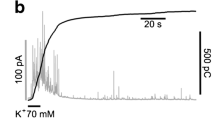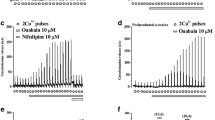Abstract
Calcium triggers the secretion of histamine from mast cells after previous exposure to sodium fluoride. The secretory process can be divided into a fluoride-activation step and a calcium-induced secretory step. It was observed that the fluoride-activation step is accompanied by an elevation of cAMP levels within the cells. The attained high levels of cAMP persist during histamine release. It was further found that catecholamines do not markedly alter the fluoride-induced histamine release. It was also confirmed that the second, but not the first, step in sodium fluoride-induced histamine secretion is inhibited by theophylline.
Similar content being viewed by others
References
M. Kaliner andK.F. Austen,Cyclic AMP, ATP, and reversed anaphylactic histamine release from rat mast cells, J. Immun.112, 664–674 (1970).
T.J. Sullivan, K.L. Parker, S.A. Eisen andC.W. Parker,Modulation of cyclic AMP in purified rat mast cells. II. Studies of the relationship between intracellular cyclic AMP concentrations and histamine release, J. Immun.114, 1480–1485 (1975).
T.J. Sullivan, K.L. Parker, A. Kulczycki Jr. andC.W. Parker,Modulation of cyclic AMP in purified rat mast cells. III. Studies on the effects of concanavalin A and anti-IgE on cyclic AMP concentrations during histamine release, J. Immun.117, 713–716 (1976).
J.C. Foreman, M.B. Hallett andJ.L. Mongar,The relationship between histamine secretion and 45 calcium uptake by mast cells, J. Physiol., Lond.271, 193–214 (1977).
J.C. Foreman, J.L. Mongar, B.D. Gomperts andL.G. Garland,A possible role for cyclic AMP in the regulation of histamine secretion and the action of cromoglycate, Biochem. Pharmac.24, 538–540 (1975).
J.C. Foreman, L.G. Garland andJ.L. Mongar, The role of calcium in secretory process: model studies in mast cells. InCalcium in Biological Systems. 30th Symp. Soc. Exp. Biol., vol. 193 (EdDuncan). Cambridge University Press, Cambridge 1976.
J.A. Chabot, P.S. Riback andD.E. Cochrane,Elevated cyclic AMP levels fail to inhibit extracellular calcium-dependent histamine secretion from rat mast cells, Life Sci.28, 1155–1162 (1981).
S.A. Patkar, W. Kazimierczak andB. Diamant,Sodium fluoride — a stimulus for a calcium-triggered secretory process, Int. Archs Allergy appl. Immun.55, 193–200 (1977).
T.J. Sullivan andC.W. Parker,Pharmacologic modulation of inflammatory mediator release by rat mast cells, Am. J. Path.85, 437–463 (1976).
P.E. Alm andG.D. Bloom,Effect of norepinephrine on in vitro histamine release from rat mast cells, Int. Archs Allergy appl. Immun.60, 60–67 (1979).
P.A. Shore, A. Burkhalter andV.H. Cohn,A method for the fluorometric assay of histamine in tissue, J. Pharmac. exp. Ther.127, 182–186 (1959).
T.J. Sullivan, K.L. Parker, W. Stenson andC.W. Parker,Modulation of cyclic AMP in purified rat mast cells. I. Responses to pharmacological, metabolic and physical stimuli, J. Immun.144, 1473–1479 (1975).
P.E. Alm andG.D. Bloom,What—if any—is the role of adrenergic mechanisms in histamine release from rat mast cells? Agents and Actions11, 60–66 (1981).
P.E. Alm andG.D. Bloom,Effects of norepinephrine on transmembrane calcium transport in rat mast cells, Int. Archs. Allergy appl. Immun.66, 427–438 (1981).
W.W. Douglas andR.D. Ueda,Mast cell secretion (histamine release) induced by 48/80: calcium-dependent exocytosis inhibited strongly by cytochalasin only when glycolysis is rate-limiting, J. Physiol., Lond.234, 97–98P (1973).
S.A. Patkar, W. Kazimierczak andB. Diamant,Histamine release by calcium from sodium fluoride-activated rat mast cells. Further evidence for a secretory process, Int. Archs Allergy appl. Immun.57, 146–154 (1978).
F.L. Pearce, M. Ennis, A. Truneh andJ.R. White,Role of Intra- and extracellular calcium in histamine release from rat peritoneal mast cells, Agents and Actions11, 51–54 (1981).
R.A. Lewis, S.T. Holgate, L.J. Roberts II, I.F. Maguire, J.A. Oates andK.F. Austen,Effects of indomethacin on cyclic nucleotide levels and histamine release from rat serosal mast cells, J. Immun.123, 1663–1668 (1979).
B.A. Fredriksson, P.E. Alm andG.D. Bloom,Changes in mast cell plasma membrane surface structure in relation to isolation procedures and histamine secretion. In manuscript.
S.J. Burwen andB.H. Satir,Plasma membrane folds on the mast cell surface and their relationship to secretory activity, J. Cell. Biol.74, 690–697 (1977).
J.C. Foreman andB.D. Gomperts,The relationship between anaphylactic histamine secretion and the permeability of the mast cell membrane to calcium, Int. Archs Allergy appl. Immun.49, 179–182 (1975).
S. Taniguchi, K. Nakazawa andM. Fujiwara,Characterization of adenylate and guanylate cyclases in rat peritoneal mast cells, Life Sci.29, 1485–1491 (1981).
D.E. Cochrane andW.W. Douglas,Calcium-induced extrusion of secretory granules (exocytosis) in mast cells exposed to 48/80 or the ionophores A23187 and X-537A, Proc. Natn. Acad. Sci. USA71, 408–412 (1974).
M. Kagayama andW.W. Douglas,Electron microscope evidence of calcium-induced exocytosis in mast cells treated with 48/80 or the ionophores A23187 and X-537A, J. Cell. Biol.62, 519–526 (1974).
D.E. Cochrane andW.W. Douglas,Histamine release by exocytosis from rat mast cells on reduction of extracellular sodium: a secretory response inhibited by calcium, strontium, barium, or magnesium, J. Physiol., Lond.257, 433–448 (1976).
M.A. Brostrom, C.H. Brostrom, B. McL. Breckenridge andD.J. Wolff,Calcium-dependent regulation of brain adenylate cyclase, Adv. Cyclic Nucleotide Res.9, 85–99 (1978).
W.Y. Cheung, T.J. Lynch andR.W. Wallace,An endogenous Ca 2+-dependent activator protein of brain adenylate cyclase and cyclic nucleotide phosphodiesterase, Adv. Cyclic Nucleotide Res.9, 232–251 (1978).
M. Ennis, A. Truneh, J.R. White andF.L. Pearce,Inhibition of histamine secretion from mast cells, Nature289, 186–187 (1981).
P.E. Alm andG.D. Bloom,Cyclic nucleotide involvement in histamine release from mast cells — a re-evaluation, Life Sci.30, 213–218 (1982).
Author information
Authors and Affiliations
Rights and permissions
About this article
Cite this article
Alm, P.E. Sodium fluoride evoked histamine release from mast cells. A study of cyclic AMP levels and effects of catecholamines. Agents and Actions 13, 132–137 (1983). https://doi.org/10.1007/BF01967316
Issue Date:
DOI: https://doi.org/10.1007/BF01967316




